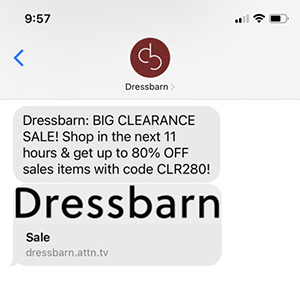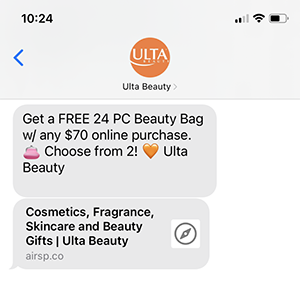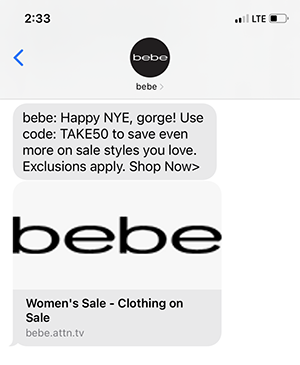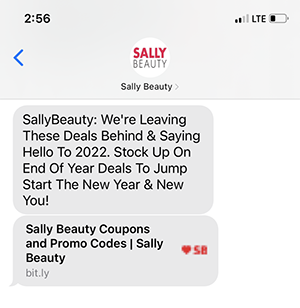SMS marketing has quickly become an essential channel for businesses. Here are seven best practices to help you make the most of it.
If you’re like the average American, you spend around 36 minutes using your smartphone to text or call people every day. Most of these communications are done without a thought. However, the rapid-fire texting you do with your friends isn’t appropriate for marketing communications.
SMS marketing is one of the more interruptive ways of communicating with consumers because people feel compelled to read text messages. The 2020 Mobile Consumer Engagement report by Sinch found that 2 in 5 consumers have more than 50 unread emails in their inbox, but only around 2 in 50 have more than 50 unread texts. Many bulk SMS providers emphasize high open rates as one of the best features of text message marketing. We see it as a sign of higher stakes.
Our team here at Campaign Monitor gathered a list of SMS marketing best practices to help you meet consumers’ expectations as you launch your text message marketing campaigns. Success requires following regular marketing rules while considering how consumers interact with texts. Your customers are likely to unsubscribe from your texts if you don’t fit into their inboxes. Follow these SMS marketing tips to make sure your texts are a welcome interruption.
1. Comply with all laws and industry guidelines
Calling legal compliance an “SMS marketing best practice” may be generous, as it’s actually more of a necessity.
U.S. legislation, including CAN-SPAM and the TCPA, have clauses that apply to SMS message marketers. Many states have their own laws that apply to SMS marketing. You can download a state-by-state guide from the Contact Center Compliance Corporation. The CTIA’s Short Code Monitoring Handbook lays out more rules in its compliance framework.
- Getting documented permission from consumers before sending any text messages by explicitly asking for customer permission, and preserving it for at least six months after they’ve opted out of SMS communications
- Making your sign-up CTAs clear so consumers know what you’ll text them and how many messages they can expect each month
- Setting up a double opt-in, where consumers must respond to a text or click a link before they’re confirmed on your list (not legally required, but is a good practice)
- Including a disclaimer about message and data rates in your sign-up message, if not every SMS you send
- Including your company name in every message you send to identify it as a marketing communication
- Sending your texts during business hours — typically between 8 AM and 9 PM local time
- Including information about how to opt-out (Reply STOP to end or HELP for help.)
If you’re not sure whether a certain message is legal, err on the side of safety.
2. Use SMS for important and immediate messages
The best SMS marketing campaigns offer consistent value to everyone on your contact list. Send time-sensitive info (like a flash sale announcement) or critical updates (like shipping notifications or two-step authentication codes) via text to improve consumers’ relationships with your brand.

We also recommend adding an element of exclusivity by rewarding subscribers with special offers. SMS-only coupons and free shipping are great perks to entice sign-ups and keep consumers on your list. Show readers the benefits of being on your list by including a clear CTA in each message.
3. Watch your send frequency
The optimal frequency for most text campaigns is one message a week. Start there — and then try varying your message cadence once you have a big enough contact list to gather meaningful data. If you know your target audience well, you might risk starting with a higher send frequency. Just don’t get too spammy. Upland data shows there’s a significant increase in unsubscribe rates once a brand reaches the threshold of 10-15 messages a month.
The reason message cadence is so important goes back to what we mentioned earlier about text messages interrupting your customers. Everything you send must be worth an immediate read. If it’s not, you’re betraying the trust your consumers put in you when they shared their phone numbers. Triggered marketing texts or automated message flows must be built with this in mind. Ask yourself whether drip campaigns and follow-ups are worth increasing the number of messages your customers receive.
Don’t forget to consider the best times to send a campaign, either. Generally, 8:00 AM to 9:00 PM local time is a good guideline — with audiences being most likely to engage between mid-morning and mid-afternoon. Sundays typically the least amount of engagement, so unless you have a particularly good, timely reason to send on a Sunday, it’s likely best to wait.
4. Be concise without sacrificing clarity
Do U want 2 rcv a msg that 👀 lyk dis from ur fave brand? Neither do we. Sure, there are only 160 characters to use and you want to make the most of them, but text speak is annoying and unprofessional. Avoid abbreviations where possible because they make texts harder to read. Stick to common ones if you must use them.
Take this example from Ulta: Instead of writing out “24-piece,” the company wrote “24 PC.” Most people can figure out what the message means, but it takes time to translate. The capitalization doesn’t help — a PC is, to most, a computer.

Make the best of your limited space by starting with something exciting. Flag a sale as “4 hours only!” or let SMS subscribers know when a deal is on its way out by telling them it’s their “LAST CALL” to shop. You can also just start with the goods. “BOGO” and “50% off” are things customers love to hear. Crafting the perfect SMS marketing message takes more time than you have characters, but doing it right pays off.
5. Lean into the conversational feeling
Your text message marketing efforts should respect the medium’s primary purpose: conversation. Readers should feel like you’re talking to them, not at them. SMS is a great place to bring your brand’s voice to life in a more personal way.
Start by using personalization and segmentation to send messages that reflect consumers’ interests and past behaviors. Then, write a text message, not a subject line. Messages should sound like they’re for one person rather than your entire marketing list.
The following efforts from bebe and Sally Beauty show why these details matter. One reads naturally and creates a connection with the customer. The other is a pain to scan and looks like a mass text sent by a computer.


Autoresponders and transactional messages allow you to go above and beyond to create a true conversational experience. However, providing real-time responses takes more resources than one-way SMS blasts. Make sure you can commit to delivering a good experience if you enable two-way communications. It’s better to only run promotional campaigns than to mess up a conversational exchange.
6. Use SMS as part of an omnichannel strategy
Your SMS marketing strategy can benefit from integration with other marketing efforts. If you have a CX or CRM system, connect it to your SMS marketing software to take advantage of existing data and add new insights. The lessons you learn from other customer interactions can guide your text message marketing efforts. Likewise, SMS campaigns may surface interesting data points that point to new opportunities elsewhere.
Successful omnichannel marketing means sending the right message via the right medium. Not everyone will sign up for SMS, which means you can’t rely on it as a primary mode of reaching people. Given the other constraints we’ve discussed — namely message length and frequency limits — SMS works best when integrated with email, social media, and other marketing tools.
7. Test, test, test!
As is the case with any marketing channel, testing will be key to your success in SMS. As much as we as marketers like to think we know what will perform best, we’re all just guessing. The only way to learn about our audience and what they respond to is by testing.
This means trying out different types of offers, different text lengths, different send times — pretty much any variable you can think of — and seeing how your audience responds.
Rules are made to be broken
You can build SMS message marketing campaigns off existing customer data, but preferences aren’t interchangeable between vastly different channels. What works in emails may not work in texts. We suggest abiding by SMS marketing best practices until you have hard data that shows you should diverge from them. Stick to what everyone else does until your list is big enough to return meaningful insights.
All campaigns and marketing strategies evolve over time, and as consumers become more used to SMS marketing, their preferences may change. Keep testing what your audience responds to. Achieving a high open rate isn’t enough to win — it’s what you do with your customers’ attention once you have it that matters.
Source: campaignmonitor.com

